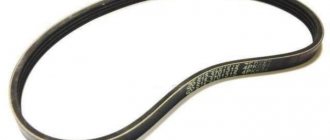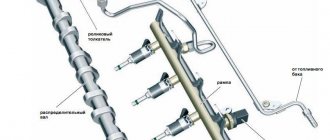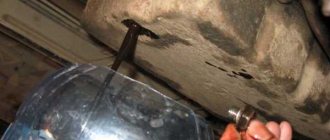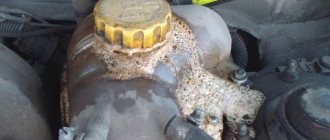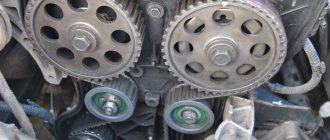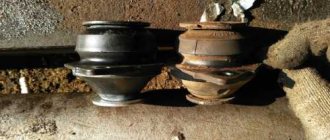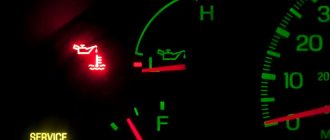Experts say that engine oil must be replaced when it reaches 10 thousand km. But despite this, drivers are faced with the problem of emulsion forming on the filler neck. In appearance, it looks like a white (yellowish), thick mixture reminiscent of mayonnaise. Newcomers are shocked by this kind of education, and for good reason. The situation can be dangerous, but most often it does not carry dire consequences. In order not to get confused when you see the substance, you need to know what to do if an emulsion appears in the engine oil.
What is an emulsion?
An emulsion is a substance that is formed under the influence of various processes. The fact is that automotive lubricants are made from hydrocarbons. When fuel burns, it releases various substances, including moisture, acid and peroxide. While the engine is running, the components are mixed with the engine oil, resulting in an emulsion. It can be found on the filler neck or on the dipstick.
Why is the emulsion white and “sticks” to these places? The fact is that the neck and dipstick are the coldest areas. The white color of the substance is due to the presence of a large number of microscopic bubbles. This also indicates severe contamination of the oil. It is necessary to immediately fix the problem by diagnosing the power unit.
Consequences of emulsion in the engine
The consequences will be as follows:
- the oil will lose its cooling and cleaning properties. This means that the engine will overheat more and more each time. The tension in constantly rubbing parts increases, since the lubricant can no longer create a protective film;
- rubbing parts are destroyed as a result of the loss of its protective properties in the lubricant;
- the power of the power unit decreases;
- the emulsion clogs hoses and pipes;
- the lifespan of the motor decreases;
- Due to overheating, the seals become tanned and all the rubber gaskets burn out.
As a result, the engine needs a major overhaul. Engine repair is an expensive business. Therefore, it is not recommended to bring it to this state.
Let's look at why emulsion may accumulate. For example, you often leave your car on the street. In autumn it rains, in winter it snows. Wet weather affects the accumulation of water in the engine crankcase. And it’s not just in the power unit that an emulsion can appear.
Similar article What happens if you pour diesel oil into a gasoline engine
A clogged vent system can also be the number one reason that allows gas to get inside the pan. But in this case, you will only need to clean the ventilation in the car and that’s it. There is no need to change the lubricant or gasket.
Reasons for appearance
Many drivers, especially beginners, are concerned about the presence of emulsion in the engine oil, the reasons for its appearance and how to eliminate it. There are actually several reasons. Each one needs to be considered separately.
One of the reasons is the appearance of condensation from the air. Air humidity changes with temperature changes. The larger it is, the more water can dissolve in the air space, forming steam. If there is too much of it when the temperature drops, the air stops holding water in this state. Accordingly, the liquid is released in the form of drops and enters the oil.
When drops fall into an oily liquid, they do not dissolve, but mix with it. At rest, water settles at the bottom of the crankcase, but as soon as the “engine” is turned on, the oil begins to circulate. While working, the motor allows the water to “split” into many small bubbles. They are whipped together with oil, turning into a foamy emulsion. The substance sticks to the plug, cap, and sometimes to the dipstick.
It is believed that in this case the emulsion does not have dire consequences. There is not enough condensation to harm the operation of the engine. In any case, after heating, the water is converted into gaseous form and the emulsion disappears. It is not always possible to notice such a phenomenon. But in winter, due to changes in low temperatures, drivers often find “mayonnaise” on the lid. There is no need to panic; this condition is considered normal.
However, there is a more dangerous method of forming an emulsion - this is getting antifreeze liquid into the oil. In this situation, water is mixed with oil in large quantities, which is fraught with negative consequences.
The “engine” is surrounded on all sides by a cooling system. The operating pressure in a sealed system is always slightly greater than atmospheric pressure. When minor problems occur, antifreeze enters the crankcase and then into the oil.
There are several reasons for this: gasket breakdown or cracks in the metal of the engine block and head. Regardless of what reason causes the emulsion to form, there will be several times more substance than if condensate enters.
In general, a white thick mass occurs in all cars. Therefore, it is important to know not only what an emulsion is in an engine, but what to do when it appears should also be studied. Unfortunately, only a small part of motorists have any idea what “mayonnaise” means on car engine components.
Ways of water entering the power unit
So, we have already found out that deformation of the block head is one of the main ways for moisture to penetrate the lubrication system, and also that the appearance of microcracks usually begins with overheating of the engine. An inexperienced driver, noticing that the temperature gauge needle begins to rise alarmingly towards the red line, checks the coolant level and, when it drops, immediately pours the missing portion into the filler neck. This cannot be done - cool liquid, if it gets into a hot engine from overheating, will lead to the destruction of the metal (physics course, 7th grade).
The opposite phenomenon, the cracking of metal when water freezes, is also described in sufficient detail in school textbooks: when water freezes, it transforms from a liquid into a solid state, expanding during the process of crystallization (due to an increase in the distance between molecules in an ordered crystal lattice). Being in the enclosed space of the engine cooling system, the ice begins to forcefully press on the surface of the walls of the engine water jacket, and if there are inhomogeneities, the metal cracks in this place.
Usually the plugs are the first to suffer; the sleeves are also considered weak points. The crack may appear microscopic, but continue to expand under the influence of unfavorable factors. Most often, deformations are directed inside the motor, and not outward, so usually such deformations are not visible externally. Getting into the CPG through these defects, moisture flows into the crankcase, diluting the oil.
Another route for oil watering can be a crack in the cylinder head, formed between the cooling and oil lines as a result of turning the liner - in this case, the piston will hit the head with force, which will manifest itself as a characteristic knocking of the engine in the crankshaft area.
The appearance of emulsion in the engine can be caused by loss of sealing rubber seals. The rubber bands of the water jacket, as well as the sleeve seals, deteriorate most quickly, and the same notorious overheating is usually the culprit. As a result, the sleeves become very hot, and the first to suffer are the rubber seals, which are not designed for such high temperatures. However, they can also be destroyed as a result of prolonged inactivity of the vehicle - this phenomenon is known as “drying out,” when the rubber product becomes covered with cracks, losing its elasticity.
What is the danger?
As soon as a “foreign” liquid (refrigerant, water, etc.) gets into the oil, over time the driver observes the formation of an emulsion. This causes the oil to lose its properties. In winter, it can crystallize, which will negatively affect the condition of the engine. The oil does not cope with its purpose, so each part is subject to severe wear.
If a minimum volume of emulsion does not cause harm to the car, then a large amount will lead to dire consequences. A small amount of condensate that gets into the oil will evaporate after 30 thousand mileage. But if coolant gets into the oil when the gaskets break, problems cannot be avoided. First, scuffs form on the surface of the cylinders. They, in turn, will damage the crankshaft liners, causing the parts of the gas distribution mechanism to “suffer”.
Coolant entering the cylinder in large volumes will cause hydraulic shock. This will lead to the breaking of the connecting rod, and then the piston debris will deform the cylinder bore and part of the combustion chamber. A power unit subjected to severe impact requires a major replacement.
What else can be said about this?
The reason for this phenomenon may also be operating conditions. Very often, foam appears on the dipstick in winter or when it gets cold. This is caused by the fact that condensation forms when a heated car cools. When the engine is hot, moisture vapor entering the oil evaporates and then condenses on the cover, for example, as shown in the photo.
Often, such condensation, in addition to the lid, also appears on the dipstick. Another reason for the formation of such muck may be bad oil. When using a good, non-scorched product, this does not happen.
The consolation is that this only occurs in winter and disappears when the weather gets warmer. Usually this phenomenon does not pose a direct danger to the engine and does not require emergency measures. However, it is necessary to carefully monitor the levels of lubricant and antifreeze; it is quite possible that what is happening is only a harbinger of a breakdown of the cylinder head gasket.
Diagnostics
To determine whether there is antifreeze in the engine oil, the driver needs to drain all the liquid into a separate container. It is advisable to warm up the engine in advance so that the oil substance heats up. As soon as the car owner drains the mixture, he will immediately be able to determine the presence of coolant in it. The fact is that the refrigerant, which contains water, accumulates at the bottom of the crankcase.
Contaminated oil must be replaced with new oil, after flushing the system. This must be done, because after draining, dirty oil remains in the system. If it is mixed with “fresh” oil, then as a result the oil will lose some of its “useful” properties.
If the driver sees that the emulsion in the engine has accumulated on the neck cover, it means that not everything is in order with the integrity of the cylinder head gasket. Cracks appear after overheating and severe wear. A broken gasket is also indicated by high consumption of antifreeze.
Sometimes breakdowns appear in the cylinder head itself and the engine block. This is facilitated either by freezing of the coolant or the use of low-quality antifreeze. The problem can be prevented if you regularly check the readings of the coolant t sensor. The main thing is not to fill the radiator (or tank) with tap water. In winter, it will freeze, thereby deforming the engine or forming cracks in the channels.
If water has accumulated in the crankcase, it can be eliminated by draining the oil completely. It is advisable to flush the engine with special fluid. There are situations where water gets into the cylinder, but this is rare. The reason for this is engine valve wear.
How to solve a problem?
So, if the reason for mixing consumables is mechanical damage to the oil cooler gasket, then it is necessary to replace it.
about 12-15 liters of distilled water; new oil cooler gasket; new antifreeze; container for collecting old refrigerant.
Step-by-step instruction
So, let's start replacing:
- If possible, add a special cleaning fluid to the refrigerant. Start the engine and let it run for a while (no more than 10 minutes). To allow the engine to warm up to operating temperature, wait for the cooling fan to start. It is recommended to flush the system before replacing the oil cooler gaskets.
- After washing, find the antifreeze drain plug under the bottom of the car. Place an old basin or any other container under it, unscrew the lid and drain the used refrigerant.
- After this, you need to dismantle the oil cooler. For each individual vehicle, instructions for disassembling the oil cooler may differ, so we recommend that you use the service book for your car. After disassembling the unit, you need to clean it completely. Remove old gaskets that have expired and install new ones in their place. Buy gaskets according to your car model. If you don't know which one is best to buy, consult your dealer.
- Having replaced the gasket, you can begin to remove the refrigerant expansion tank. Rinse it as much as possible. It won't be possible to wash it completely, so if you are too concerned about its appearance, you can replace the tank with a new one.
- When the coolant is drained and the expansion tank is flushed, you need to flush the system several more times. Replace the tank and fill it with distilled water. Start the engine and turn off the air flow inside the car. Also turn on all voltage consumers to maximum so that the motor warms up faster. When the operating temperature of the internal combustion engine rises to 100 degrees, the cooling system fan will turn on. Let the engine run for about 10 minutes, while turning off all voltage consumers and turning on the interior airflow. The motor will begin to cool slightly and the cooling fan will turn off. Wait about 15 minutes for the motor to cool slightly, otherwise you may get burned when draining the distillate. Drain the distilled water and repeat the procedure at least one more time. The system must be flushed until the drained distillate becomes almost transparent. Of course, it should be free of any traces of motor fluid.
- After this, you can tighten the drain plug and fill in fresh antifreeze. Use only original products recommended by the car manufacturer. If you purchase a counterfeit, this may be fraught with other problems.
- Start the engine and press the gas pedal firmly several times. At this point you will need the help of another person. When you press on the gas, an assistant should squeeze the cooling system pipes. In this case, the expansion tank cap must be closed. This is done in order to prevent the occurrence of air jams and eliminate those that have already appeared in the system. Open the expansion tank cap from time to time to release any trapped air.
What should you do if you detect an emulsion?
Having found out what consequences the emulsion in the engine entails, drivers begin to look for ways to remove “mayonnaise” from parts.
The first thing an owner should do is perform a few checks. First you need to warm up the engine to operating temperature and drive the car for about 20 km. After this, you should re-inspect the cover and the control dipstick. Do not forget that after driving the cover and oil will be quite hot. To avoid getting burned, manipulations should be carried out carefully.
If it turns out that the emulsion has disappeared, then do not worry. You are allowed to travel further by car. This happens often after the onset of cold weather. Some drivers advise using anti-emulsion additives. For prevention, you can also adapt insulation for the “engine”.
If the emulsion has not disappeared, but has formed even more, then it is worth checking for depressurization of the cooling and oil system. We also recommend determining the amount of antifreeze in the tank. If the coolant disappears quickly, this may mean that it is being poured into the oil. In this case, you need to make a diagnosis, while temporarily not using the car.
How to determine antifreeze in oil
Many, especially novice, car enthusiasts are interested in the question of how to find out that antifreeze has entered the oil system of the car’s engine. In fact, there are a number of typical signs by the presence of which one can judge the occurrence of this malfunction. Among them:
- At the neck under the lid, an emulsion of oil and antifreeze appears, usually white or yellowish in color, similar in appearance to cream (sour cream, mayonnaise). Accordingly, the more antifreeze or antifreeze that has leaked into the oil system, the more such a mixture will be in its composition. It is not difficult to check the presence of an emulsion; to do this, you just need to look at the condition of the engine oil on the dipstick. There will be a similar emulsion on the oil filler neck, just open the cap.
- Drop in coolant level. This sign is indirect, since antifreeze can leave the system not into the oil, but simply into the engine compartment. Therefore, in this case, additional diagnostics are necessary.
- Engine overheating. This symptom is also indirect, since it can be caused by other problems. However, if antifreeze and oil are mixed, then, accordingly, the cooling and lubrication systems will stop working normally, which will also lead to rapid overheating of the engine, especially when it operates at significant loads (speeds).
- Presence of oil in antifreeze. As a rule, when one (or both) systems depressurizes, mutual mixing of these process fluids occurs. At the same time, the antifreeze turns black and begins to smell like burnt oil, and the cooling system does not work well. You can look at the condition of the antifreeze by opening the cap of the expansion tank of the cooling system.
- Decrease in engine power. This factor is a logical result of the deterioration of the cooling and lubrication systems. Often the motor “troits”. Additional diagnostics must be performed as other problems may be causing the loss of power.
- White smoke from the exhaust pipe. This is true for both gasoline and diesel engines, however, the reasons why this phenomenon is caused differ in the first and second cases. If white smoke comes out of the exhaust system, then there is antifreeze in the engine elements. For gasoline engines, the coolant enters the cylinders, and for diesel engines, it enters the manifold.
- The spark plugs will have a light tint (the color of burnt antifreeze). True, this is only an indirect sign; a number of other reasons will need to be considered.
- Air bubbles in the expansion tank of the cooling system. They can be seen through the transparent tank body or by opening the cap (at high engine speeds). The higher they are, the more air will escape from the system. This sign directly indicates depressurization of the system.
- Coolant leaks from under the cylinder head gasket onto the body of the unit itself. At the same time, regardless of their color, it is necessary to check the condition of the engine oil and antifreeze in the engine to ensure they are mixed with each other.
If a car owner encounters one or more of the symptoms listed above, then it makes sense to check the condition of the engine oil, coolant, and also perform additional diagnostics of individual engine parts, which will be discussed below.
What to wash with?
If it turns out that the emulsion was formed due to antifreeze getting into the oil, then it is worth flushing the engine. Today, special means are used for these purposes. These include waste additives and flushing oils.
When choosing a product, the driver must proceed from the purpose of flushing. For example, if he needs to carry out a procedure before changing the oil, then a regular five-minute liquid will do. But in a situation with an emulsion, it alone cannot do it.
Flushing oils are excellent for flushing out the white emulsion from the internal combustion engine. But the risk of clogging channels and filters with dissolved dirt still exists. You need to work with the substance carefully.
There is a popular method that helps to wash without risking other parts of the car. To do this, you need to mix mineral oil and diesel fuel in a 3:1 ratio. The resulting mixture is used to perform several washing cycles at idle speed. By the way, it is enough to carry out one cycle with flushing oil. After this, you can fill in new oil.
What threatens the appearance of an emulsion?
Having turned into a water emulsion, the oil completely loses all its carefully balanced properties. Left without lubrication, the parts will instantly go into semi-dry friction mode, local overheating will begin, metal destruction will begin, and the motor will be irreversibly damaged.
The most heavily loaded main and connecting rod bearings of the crankshaft will suffer first. They work with small gaps filled with an oil film under significant pressure.
Water does not have the strength of this film, so metal will work on metal, which will instantly release a large amount of heat, the liners will partially melt and rotate in the shaft beds. This is enough to jam and stop the engine, accompanied by strong knocking.
Recommendations for preventing the formation of condensate-type emulsions
To prevent the formation of a condensate-type emulsion, you must follow some recommendations:
It is forbidden to warm up the car for too long after a long period of parking. The optimal engine operating time is 5-10 minutes. It is also not recommended to start right away. You need to start driving at gentle speeds, otherwise the rise in engine temperature will be sharp and lead to unpleasant consequences.
It is advisable not to travel short distances unless absolutely necessary in winter. The fact is that the engine will not be able to warm up well, and it will need to work under load.
It is worth traveling long distances from time to time. Even if condensation has already formed, it will have time to “evaporate” during a long trip.
Ultimately, it is worth trying the use of emulsifiers and insulating the motor. Perhaps these methods will seem effective.
It must be remembered that to get rid of the emulsion caused by condensation, the engine is not flushed. The procedure is necessary only when antifreeze gets into the oil.
Where can engine oil leak from?
If during the next daily inspection it turns out that the oil level is significantly below the maximum mark, you should seriously look into troubleshooting
First of all, it is important to determine where the leak is located.
First of all, it is advisable to pay attention to the accessible engine components. One of them is the valve cover.
From under the valve cover
A leak in the valve mechanism may result in oil leakage from the engine lubrication system. Often, this problem is signaled by a characteristic burning smell from under the engine exhaust manifold.
In this case, it cannot be said with a high degree of probability that replacing the gasket will solve the problem. The occurrence of the presented malfunction may be associated with excessive pressure in the engine lubrication system.
This situation can be caused, for example, by a malfunction of the so-called pressure reducing valve.
Crankshaft oil seal
If a leak in the valve cover gasket can be corrected with little effort, as they say, the situation with the crankshaft oil seal is much more complicated. Replacing it due to the design features of the engine will require a lot of time and labor.
What could have caused the breach of its tightness?
Let us arrange the most probable causes of this malfunction in a certain sequence, starting with the most frequent:
- the operational resource has been developed;
- failure in the crankcase ventilation system;
- defective components;
- unscrupulous repairs.
Oil leak between engine and gearbox
Do not forget that the clutch flywheel housing also contains an oil seal, which sometimes makes itself felt, although extremely rarely. To verify the presence of such a malfunction, you will have to look under the bottom of the car.
In this case, it is best to drive the car into an inspection hole or so-called overpass. The presence of a leak will be indicated by an oily surface of the clutch housing and gearbox housing. To replace the oil seal, you will need to dismantle the gearbox.
Let us focus our attention on the reasons for this unfavorable phenomenon. Among them are:
- mismatch of lubricant viscosity;
- failures in the crankcase ventilation system;
- loss of elasticity of rubber goods;
- poor quality components.
Oil filter gasket
The oil filter seal can also be the culprit for an oil leak. So, during the next scheduled filter replacement, it could simply be tightened, and this is unacceptable. With such repairs, unfortunate oil leaks may appear over time.
It is also worth mentioning the fact that after each filter replacement, all associated rubber goods must be replaced. If this is not done, there is a high probability that oil formations will soon appear at the filter connection site.
In a particular case, oil from the engine lubrication system may be squeezed out due to malfunctions in the operation of the VKG system.
Engine crankcase problems
A frequent cause of engine oil leaks can be violations of the crankcase ventilation system. For the most part, owners of fairly used cars face a similar problem.
The fact is that as the CPG wears out, exhaust gases begin to accumulate in the engine crankcase. With a working crankcase ventilation system, excess pressure would be vented into the engine intake manifold. But it also happens that after prolonged use, and in the absence of proper care, the elements of the system become clogged.
This state of affairs leads to the fact that the gases have nowhere to go, and they begin to look for the most vulnerable places, which are played by various sealing elements.
More about condensate
Even those who store their cars in a garage face this problem. But most often it bothers those who park their cars in the yard. If a car regularly spends the night outside in the fall during the rainy season, then a large amount of water vapor may well enter the crankcase cavity. They condense in pipes and on oily surfaces. At one time, 1-2 g of condensate can enter the motor. This is quite enough to form an emulsion on the oil filler cap. By the way, bubbles will also be visible on the dipstick. In winter, the owner will see “mayonnaise” very often. If the car is constantly driven short distances and the engine does not warm up to 90 degrees, then this is also one of the reasons why condensation accumulates in the engine. “Treatment” is carried out by long runs, or warming up to operating temperatures.
Flushing the engine oil system: when needed
So, antifreeze or antifreeze can get into the lubrication system for various reasons, but the most common culprit is damage to the cylinder head gasket. Less commonly, cracks form in the block or head. In any case, the result of mixing oil and coolant is an emulsion.
This phenomenon is very dangerous for the engine, since the lubricant loses its properties, and the wear of the cylinder head, crankshaft, timing gear and other elements and components in the internal combustion engine increases significantly. Moreover, water and ethylene glycol, mixed in certain proportions and, in fact, representing coolant, after entering the oil, cause coagulation of various contaminants.
Simply put, dirt in the lubrication system literally sticks together. Additives in oil and antifreeze react after mixing and quickly decompose, the oil immediately oxidizes, etc. Large “lumps” consisting of deposits can even clog the oil receiver mesh filter, resulting in oil starvation of the engine.
It is important to take into account that, for example, after replacing the cylinder head gasket, it will not be possible to completely drain the waste from the engine. This means that if you fill in a new portion of fresh lubricant, the lubricant will also mix with the remaining emulsion, and unwanted deposits will still form in the oil channels and on the internal surfaces of the engine.
If the engine is not additionally flushed, this situation will repeat for at least 2-3 more replacements. We also note that similar recommendations also apply when, for some reason, the oil change interval was violated (for example, the lubricant was replaced not after 10 thousand km, but after 15 thousand). Flushing is also recommended if it is necessary to add oil from a third-party manufacturer, when it was necessary to mix mineral oil and synthetics, etc.
At the same time, flushing the engine may be necessary if the owner purchased a used car, and the service history of a particular car is unknown or questioned. It often happens that after changing the oil on such a machine, the fresh lubricant turns black very quickly (literally after 50-100 km).
Finally, it is also worth highlighting the possible filling of low-grade oil into the engine. Unfortunately, fakes are often found among motor oils. Naturally, after discovering this fact, you need to remove the surrogate from the internal combustion engine, then the engine must be flushed.
A counterfeit product is usually indicated by strong and rapid blackening of the lubricant, an unpleasant pungent odor, the appearance of black deposits under the valve covers, cloudiness of the oil, a significant change in its viscosity for no obvious reason, increased lubricant consumption, engine smoking, etc.
Ways to deal with condensate emulsion
To avoid the appearance of an emulsion of a condensate nature, you must follow these simple recommendations:
- You should not get carried away with warming up your car for a long time after a long period of parking. The reason is obvious - when the engine is running at idle, the crankcase ventilation system is practically not involved. Moreover, in winter, reaching operating temperature without load can take a very long time. In reality, it is enough to let the power unit work for 5-10 minutes - this is enough to, for example, clear the car of ice and snow. True, you can’t immediately accelerate, but if you move at gentle speeds, the engine temperature will rise to the operating level much faster and with less consequences;
- short trips should be avoided, especially in winter, since the engine, without having time to warm up, is forced to work under load;
- to get rid of condensation, it is necessary from time to time to make long trips at cruising speeds - this is the ideal mode for evaporating condensation that has managed to form;
- you can try using emulsifiers - special additives that prevent the formation of condensation;
- Finally, insulating the engine in winter will also reduce the risk of condensation emulsion.
Note that flushing the engine from emulsion is practically not used in this case.
Additional symptoms of trouble
As already noted, an emulsion is a mixed mixture of water and oil in the form of foam. A copious amount of white or yellowish foam on the cover and dipstick indicates that liquid is leaking into the engine crankcase, and it is present only in the cooling system. Therefore, the location of the leak should first be looked for in those parts of the engine where the lubrication and cooling channels run nearby.
Note that the appearance of a coolant leak inside the engine may be accompanied by a number of other signs:
- A constant decrease in the coolant level in the expansion tank and the need for periodic topping up.
- Oil film in the expansion tank.
- The interior heating system provides virtually no heat.
- The engine oil level is higher than normal.
- Copious white smoke from the exhaust pipe.
- Interruptions in engine operation.
All this indicates that antifreeze has entered the oil channels. If you do not take any action and continue to operate the car, the engine will be damaged due to lack of normal lubrication, and expensive major repairs or a complete replacement of the engine will be required to restore functionality.
Faulty crankcase ventilation system
If the ventilation system is clogged and does not work as it should, then gases and vapors will try to escape through the dipstick and other places in the internal combustion engine. In this case, it is not surprising that an emulsion appeared on the oil filler cap.
The only good thing is that the oil is clean and there is no antifreeze in it. If you fix the crankcase ventilation system, then you won’t even have to replace lubricants.
Flushing agents
Car owners resort to the following methods as cleaning agents.
Water
You need to prepare distilled or at least boiled water. This option can only be used if the cooling system is slightly contaminated. Water is poured into the radiator, after which the engine is heated to operating temperature and everything is drained. To get rid of the emulsion, you will have to repeat the procedure 5-6 times. This is an ineffective way to flush the system of oil, but it is the most affordable.
Flush the cooling system with water until clear liquid drains out.
Milk serum
You can use whey. Before use, the whey must be strained through cheesecloth to remove any clots and sediment present in it. Craftsmen recommend different periods of time for keeping the whey in the cooling system. Some drive with it for 200–300 km, others fill it up, warm up the engine and drain it.
If after draining the whey there are a lot of clots and oily formations, then it is recommended to repeat the cleaning procedure.
The serum is not very effective in the fight against oily deposits.
Fairy
Use Fairy or similar dishwashing detergent. Pour 200–250 grams of this product into a large amount of water, depending on the degree of contamination of the system, and stir. The engine is warmed up and left for 15–20 minutes.
If after draining there are a lot of impurities in the liquid, then the procedure is repeated. During washing, the detergent begins to foam strongly, so you need to monitor the condition of the expansion tank. This option helps to effectively remove oil from the system, but its disadvantage is the formation of a large amount of foam. It is necessary to rinse the system several times with water until the remaining detergent is removed.
During heating, detergents begin to foam strongly, so you need to monitor the expansion tank
Powder machine
This option is similar to using dishwashing detergent, so it also works well at clearing oil from the system. The advantage is that using an automatic powder produces less foam. When creating a solution, add 1 tablespoon of powder per liter of water.
Diesel fuel
This is the most effective folk method. Fill the system with diesel fuel, warm up the engine and drain the diesel fuel. The procedure is repeated at least twice, and before adding antifreeze, rinse with water.
Some people are afraid that diesel fuel may ignite or damage the pipes. Folk craftsmen claim that nothing like this happens and the method works very effectively. To warm up the engine faster, it is recommended to remove the thermostat while flushing it with diesel fuel.
Special fluids
You can purchase special liquids for flushing the cooling system in the store. This is the best option for cleaning the cooling system from oil, but it is more expensive than using traditional methods.
Special liquids for flushing the cooling system can be purchased at any auto store.
Each such remedy has instructions according to which you must act. A certain amount of special liquid is poured into the system. Let the engine run for 30–40 minutes and drain, then flush the system with water.
Sources
- https://zen.yandex.ru/media/id/5affac9a1aa80c5715437e35/kak-i-pochemu-poiavliaetsia-emulsiia-v-motore-5b195c1bc3321bdbfd798a6e
- https://mashinapro.ru/1826-emulsiya-na-schupe-urovnya-masla.html
- https://DriverTip.ru/repair/pochemu-poyavlyaetsya-emulsiya-v-masle-dvigatelya.html
- https://KrutiMotor.ru/emulsiya-na-maslyanom-shhupe-i-kryshke-maslozalivnoj-gorloviny/
- https://avtocity365.ru/ustrojstvo-i-ekspluatatsiya-avtomobilya/emulsiya-v-masle-dvigatelya/
- https://KrutiMotor.ru/promyvka-dvigatelya-ot-emulsii-v-masle/
- https://autochainik.ru/emulsiya-v-masle-dvigatelya.html
- https://bumper.guru/klassicheskie-modeli-vaz/sistema-ohdazhdeniya/chem-promyt-sistemu-ohlazhdeniya-dvigatelya-ot-masla.html
Cylinder head gasket failure
If emulsion is visible on the oil filler cap, the reasons are often a leaky gasket. A breakdown is possible due to burnout due to overheating or as a result of physical obsolescence and wear of the gasket. But such cases occur only on old engines that have not been monitored. The main sign of a breakdown is unstable operation of the motor. The coolant leaving the expansion tank will also be noticeable. If you carry out diagnostics in a timely manner, then you can limit yourself to only replacing the gasket. This is done in literally two hours. If you let go of the situation, then everything will be much worse.
